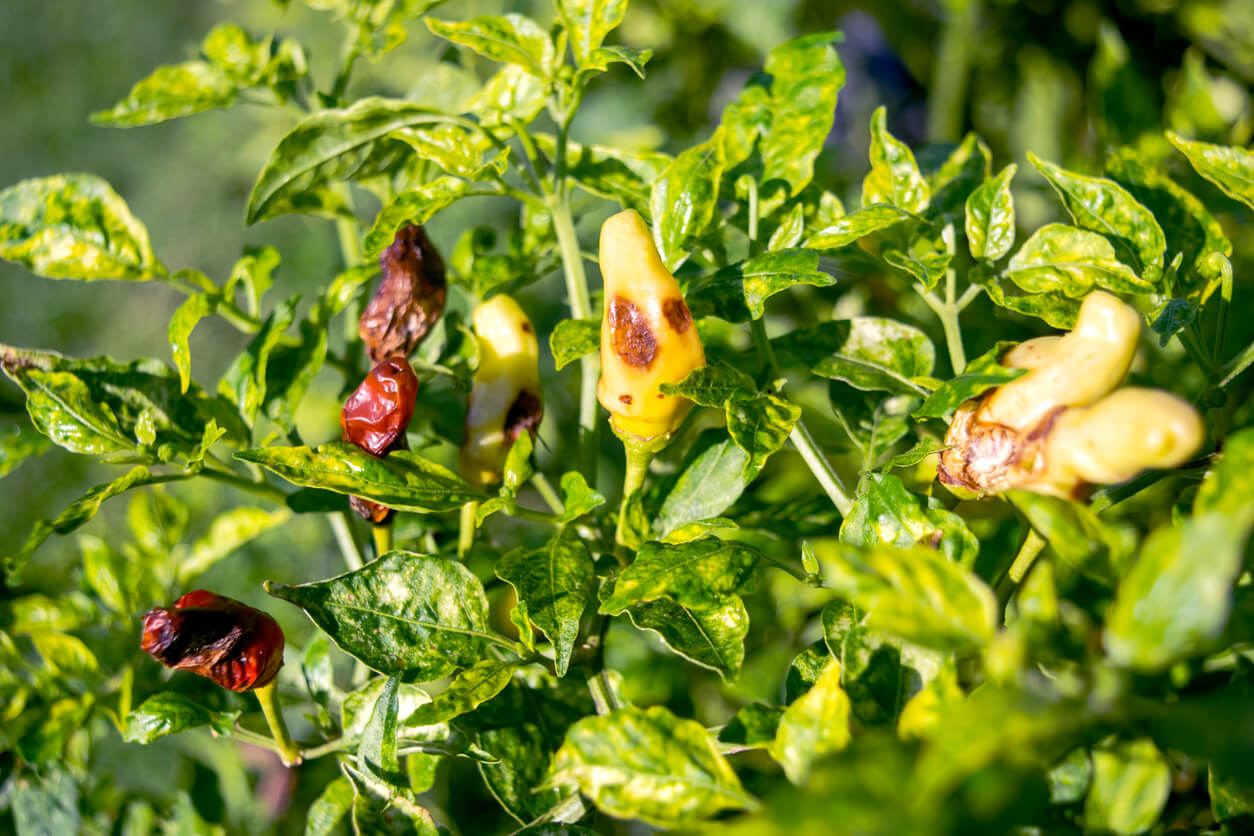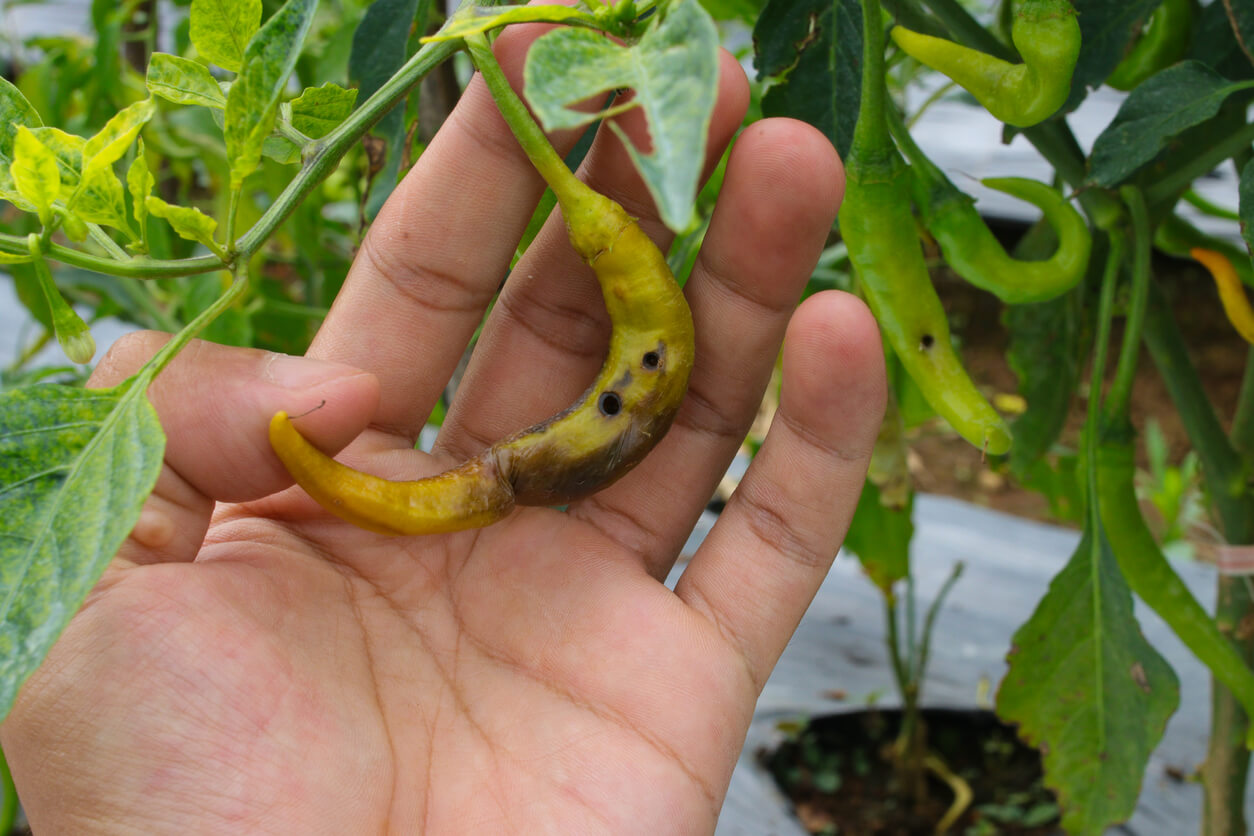
Hot pepper plant infected by fungal disease
Like all food crops, hot peppers are susceptible to various fungal diseases. Your greatest weapons against these are best planting practices, which help prevent disease in the first place.
This is especially important, as there are no fungicides approved for home use for many diseases.
These best planting practices are aimed at producing strong, healthy plants that can withstand disease, and at avoiding situations that contribute to the development of disease. They involve keeping plants clean, dry, and undamaged.
Companion planting. Each crop has a garden buddy that helps out in some way: repelling pests, attracting pollinators, contributing nutrients to the soil. We discuss this in more detail in the Planting section of this gardening guide. You can also review our Food Gardening Network Companion Planting Chart for a full list of good planting partners for your garden.
Crop rotation. As tempting as it might be, it’s best not to grow the same crops in the same soil—open garden, raised bed, or container—for more than one growing season. Each plant takes certain nutrients from the soil and leaves others behind. Some crops are susceptible to soilborne diseases or particular pests. For these reasons, you want to rotate your crops from growing season to growing season. This will help ensure better soil health and healthier, more productive harvests. This practice applies primarily to annual crops; perennial crops can usually continue to grow where they’re planted.
Now, in a perfect gardening world, you would be able to implement a crop rotation plan that spans decades. There are some soilborne diseases that can live in the soil for up to 20 years!
Even so, it’s a good idea to switch things up from season to season. Below is a list of vegetable crops by category. The general rule of thumb here is to plant crops from one list in the growing space of the crops in the following list in the next growing season. So, you would go from List 1 to List 2 to List 3 to List 4 and then back to List 1.
List 1: Root, solanaceous (nightshade), and tuberous crops
- hot peppers
- carrots
- celery
- eggplant
- parsnips
- potatoes
- sweet peppers
- sweet potatoes
- taro
- tomatoes
List 2: Brassicas
- broccoli
- Brussels sprouts
- cauliflower
- kale
- kohlrabi
- mustard
- radishes
- rutabaga
- turnips
List 3: Legumes and pod crops
- broad beans
- lima beans
- okra
- peas
- runner beans
- snap beans
List 4: Alliums
- bulb onions
- garlic
- leeks
- oriental bunching onions
- scallions
- shallots
- Welsh onions
Here’s a short example of a common crop rotation plan:
potatoes > corn > cabbage > peas > tomatoes > beans > root crops > squash/potatoes > onions
If you can’t do a complete crop rotation, consider alternating what you grow from one season to the next—a virtual crop rotation of sorts. With containers and raised beds, you have the option of changing out the soil, depending on what you want to grow there. Some container soil, especially, will be severely depleted of nutrients at the end of the growing season and should just be replaced.
Mulch. Mulch can help with water retention—but be vigilant and check for insect or fungal activity.
Watering. Water your hot peppers deeply about once a week (check the soil for dryness). Do not overwater. Soggy soil invites disease.
Other best practices include:
- Buy healthy, disease-free seeds from reputable sources.
- Plant your hot peppers in full sun.
- Plant in sites with good drainage; if planting in open ground, choose a higher spot for better drainage.
- Check plants regularly for signs of disease.
Common Hot Pepper Diseases

Cayenne pepper plant infected by disease
Here are some of the usual culprits that might infest your hot pepper plants. Remember, it’s important to remove infected plant material (leaves, roots) to prevent the spread of disease once it’s found its way onto your plant.
Anthracnose
Cause: Fungus
Symptoms:
- leaves turn yellow at the tips, eventually turning brown all around
- browned, dying leaves
- dark, sunken lesions on fruit and/or stems
How it spreads:
- spores spread by rain and splashing water
- wind
Treatment:
- remove all infected parts
- clear ground of leaf and twig litter
- apply liquid copper fungicide to reduce recurrence
Prevention:
- prune plant to provide good air circulation and access to sunlight
- provide proper water and fertilizer
Bacterial leaf spot
Cause: Bacteria
Symptoms:
- leaves have circular spots with irregular edges
- spots may turn yellow and water-soaked
- leaf drop
How it spreads:
- water
- wind
- garden tools
- thrives in warm, moist conditions
Treatment:
- remove and discard infected leaves
- if infection becomes serious, discard entire plant
- do not compost infected plant material
Prevention:
- mulch around plants to prevent water from splashing onto leaves
- avoid overhead watering; water at soil level
- make sure plants have good air circulation and lots of sun
- sterilize garden tools before each use
- spray plants weekly with neem oil or a commercial fungicide, such as Bonide Revitalize
- rotate crops annually; see crop rotation guidelines in this gardening guide
Blossom-end rot
Cause: Calcium deficiency
Symptoms:
- water-soaked area on end of fruit where the flower was
- lesion on side of fruit
- lesion enlarges and turns brown and leathery
How it spreads:
- caused by a calcium deficiency in the soil
Treatment:
- keep soil pH at 6.5
- lime soil to increase calcium content
- mulch to retain soil moisture
Prevention:
- test soil before planting
- water consistently
- avoid excessive amounts of nitrogen fertilizer
Cercospora leaf spot
Note: This is the most common disease that occurs on hot pepper plants.
Cause: Fungus overwinters in infected plant material and emerges in warm, humid weather, most commonly after a rainy spell. It does not affect the fleshy root of the plant.
Symptoms:
- yellow and brown spots on the underside of leaves
- leaves may curl and turn upward
How it spreads:
- fungus overwinters in infected plant material
- wind, insects, and birds
Treatment:
- remove and destroy infected areas
Prevention:
- apply liquid copper fungicide
- if necessary, apply sulfur-based fungicide
- plant disease-resistant varieties
- remove plant debris
- rotate crops annually; see crop rotation guidelines in this gardening guide
Damping-off
Cause: Fungus
Symptoms:
- water-soaked, decomposing seeds
- infected roots are gray and water-soaked
- seedlings grow but then collapse and die
- older plants that get infected are severely stunted
How it spreads:
- spores thrive in moist soil and cool temperatures
Treatment:
- if infection is severe, apply liquid copper fungicide
- remove and discard infected parts
Prevention:
- minimize soil moisture
- plant in well-draining areas
- avoid overhead watering; water at soil level
- treat seeds with fungicides before planting
- rotate crops annually; see crop rotation guidelines in this gardening guide
Phytophthora blight
Cause: Fungus-like organism (Phytophthora capsica)
Symptoms:
- large, brown leaf spots
- rotting fruit
- crown rot
- dieback
- blackening of roots
- wilting plants
- bottom of leaves may have white spores
- fruit may also be covered in white spores as they rot
How it spreads:
- over-watered soil
- splashing of water from infected soil
- can live in the soil for years
- contaminated seeds
Treatment:
- remove and discard infected plant matter
- soil solarization
Prevention:
- use straw mulch
- apply liquid copper fungicide
- install drip irrigation
- plant disease-free seeds
- rotate crops annually; see crop rotation guidelines in this gardening guide
Powdery Mildew
Cause: Fungus overwinters on infected plant debris and emerges in warm, humid weather.
Symptoms:
- white, powdery patches on leaves
- leaves may curl and turn upward
- new shoots appear stunted
- older infections look like a tan or reddish-brown felt covering; these contain spores
- heavy mildew infections can stunt a plant’s growth
How it spreads:
- fungus overwinters in infected plant debris
- spores do not need moisture to germinate; often called a “dry weather disease”
- wind, insects, and birds
Treatment:
- remove and destroy infected plant matter
Prevention:
- apply liquid copper fungicide
- if necessary, apply sulfur-based fungicide
- plant disease-resistant varieties
- remove plant debris
- rotate crops annually; see crop rotation guidelines in this gardening guide
Pepper mosaic and Pepper mild mottle virus (PMMoV)
Cause: Virus
Symptoms:
- stunted plants
- malformed fruits
- poor crop yield
How it spreads:
- aphids and other insects that prey on pepper plants
Treatment:
- remove and discard infected plant matter
- if infection becomes serious, discard entire plant
- do not compost infected plant material
Prevention:
- control aphids and other insects
- plant disease-resistant varieties
- rotate crops annually; see crop rotation guidelines in this gardening guide
Tobacco etch virus (TEV)
Cause: Virus
Symptoms:
- dark green vein bands on leaves
- malformed leaves
- stunted plants
- plants wilt and die
How it spreads:
- aphids and other insects that prey on pepper plants
Treatment:
- remove and discard infected plant matter
- if infection becomes serious, discard entire plant
- do not compost infected plant material
Prevention:
- control aphids and other insects
- plant disease-resistant varieties
- rotate crops annually; see crop rotation guidelines in this gardening guide
Tobacco mosaic virus (TMV)
Cause: Virus (highly infectious)
Symptoms:
- curling leaves
- mottled fruits
- stunted plant growth
- excessive leaf drop
How it spreads:
- aphids and other insects that prey on pepper plants
Treatment:
- remove and discard infected plant matter
- if infection becomes serious, discard entire plant
- do not compost infected plant material
Prevention:
- control aphids amd other insects
- plant disease-resistant varieties
- rotate crops annually; see crop rotation guidelines in this gardening guide
Which diseases have you had to treat on your hot peppers? Please tell us how you prevent and handle diseases. If you spot other symptoms on your hot peppers that are not mentioned here, contact your local extension center or garden center for a consult—and please let us know what you discover.


 Previous
Previous

